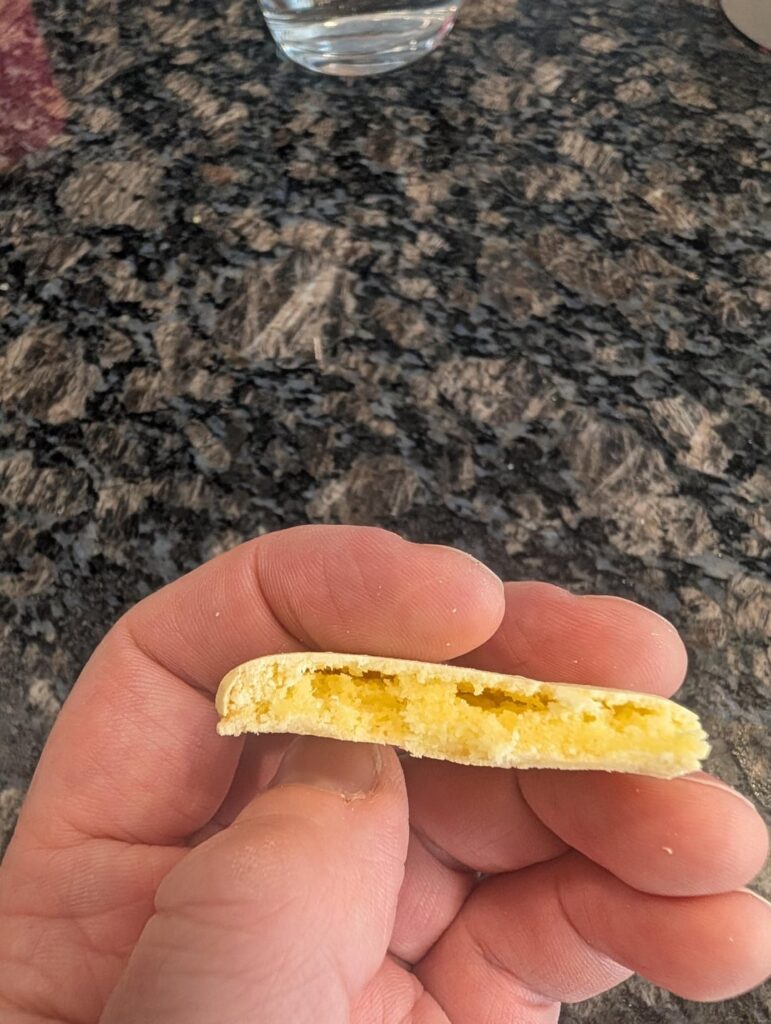

Hi Team,
I've been able to make macarons decently over the last year – though they've been generally pretty hollow (see yellow macaron).
No matter how much I focus on the meringue or macronage process, I get this pocket of air. This is one of the better ones. Which, I get, is not the worst…. But for perfection, it still bothers me.
I tried to lower my oven by 10° and cook for an additional 2 mins based on ChatGPT's suggestion that steam was getting trapped under the shell. Results were old wrinkly men looking macs. (See attached).
Where am I going wrong here, crew? Any thoughts?
Recipe:
Pies and Tacos Basic Swiss Macaron
Oven:
Convection
265° normally for 13.5 mins.
Baked on an upside down tray on a silicone mat.
by JQuadGMono


3 Comments
The wrinkled tops make me think you’re over doing the macaronage or underwhipping the meringue. Ultimately, the batter is too fluid and lacks stability, which means it can’t hold all the tiny little bubbles that make up the structure of the macaron, so the bubbles are instead combining into one big bubble underneath the “skin” of the shell. I’ve only made swiss meringue macarons once but I was amazed at how long it took for eggs to whip up, both to just start looking like a meringue and to get to stiff peaks. I was worried I’d accidentally gotten oil in the egg whites, but they just needed more time.
However, if you’re getting hollow shells that otherwise look perfect and smooth (which was the bane of my baking for a long time), I found that adding a minute or two to the bake time fixed the problem for me. It seemed like they were baking perfectly, but then the inside of the shell was collapsing as they cooled. Adding a little more bake time stabilizes the interior of the shell so that doesn’t happen. They might seem a little crispy when they come out, but once they’ve had overnight to “cure” with the filling, you’d never know it. Pierre Herme is big on the “maturation” process. It’s the reason I always hate to see bakers serve fresh out of the oven macarons on TV competitions.
I also just saw that you’re using convection and 265 for 13 minutes. I never use convection because I worry about the air movement screwing with my macs. I bake my macarons with out turning on the convection, at 290 degrees for about 15 minutes.
I also saw that you tried reducing by 10 degrees and adding a couple of minutes. Personally, I would try adding a couple of minutes before reducing. The only time I try lower temperatures is if I’m having issues with browning, and we’re already baking at such a low temperature that it shouldn’t be an issue (though I know it tends to be more of an issue with convection ovens).
I know some people use convection with success, but something to keep in mind is that most modern convection ovens will actually reduce the temp to some degree to better match the “conventional” equivalent, so setting your oven to 265 might be going too far down. If you want to play around with baking temp and times, I’d consider adding time. If that doesn’t work without browning, then I’d increase the temp by 5 degrees until you get to one that seems to consistently work.
I agree you may be over mixing. I own a commercial bakery. We use a commercial turbofan oven. I bake our macarons at 320 low fan for an average of 13-15 minutes, however humidity is a big factor in my opinion. We put ours in front of a fan for about 15 minutes until they have a good skin before putting in oven. I find the most important things are whipping your egg whites til good and stiff and not over mixing during macronage. You will eventually get a feel for it the more you do it.